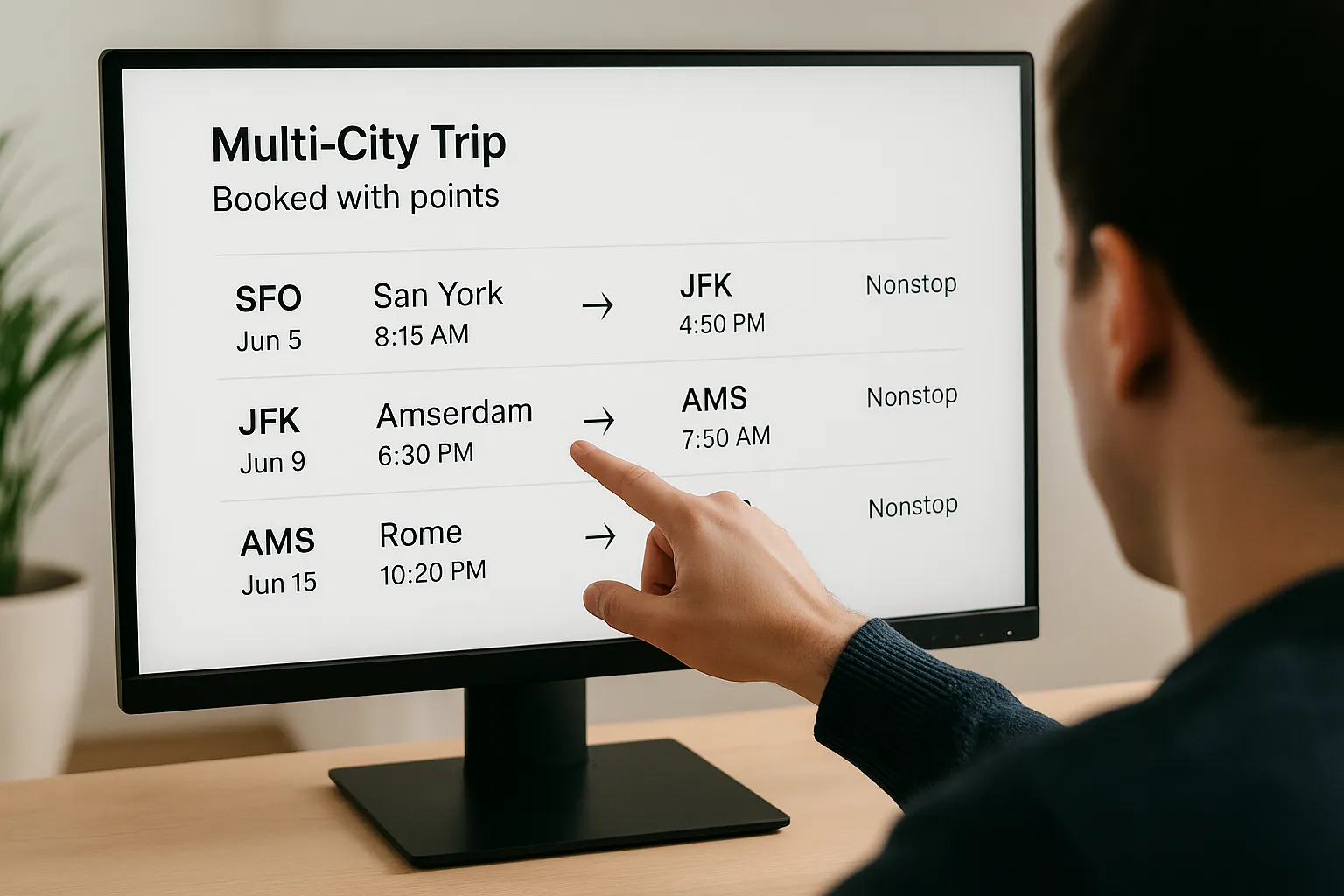On This Page
Imagine booking a flight from New York to Tokyo, but spending five days exploring the historic streets of Vienna on the way—without buying a separate plane ticket. This isn’t a glitch or a travel fantasy; it’s a stopover, and it’s one of the most powerful tools in the world of travel rewards. For anyone asking “What Is a Stopover Flight?“, the answer is simple: it’s your key to unlocking a second vacation for free. It’s a deliberate, extended pause in your journey that transforms a simple connection into an immersive travel experience.
While some airlines offer paid stopover programs, the true magic happens when you leverage your credit card rewards. By understanding the rules of different frequent flyer programs, you can strategically book these “two-for-one” trips using your points and miles. This guide will demystify the entire process. We will not only provide a clear answer to “What Is a Stopover Flight?” but also give you the exact playbook for finding and booking these awards, turning your hard-earned points into extraordinary travel stories.
Full Comparison
The first step to mastering the stopover is understanding how it differs from a layover or an open-jaw itinerary. These terms are often confused, but they have very different implications for your travel plans and your use of points and miles.
| Itinerary Type | Definition | Duration of Stop | Example |
|---|---|---|---|
| Layover (or Connection) | A short stop in a connecting city required to change planes on the way to your final destination. | Typically under 24 hours for international flights (or under 4 hours for domestic U.S. flights). | Flying from Chicago to Rome via a 3-hour stop in Frankfurt to change planes. |
| Stopover | A planned, extended stop in a connecting city, allowing you to leave the airport and explore for one or more days. | More than 24 hours on an international itinerary. | Flying from Chicago to Rome with a planned 4-day stay in Frankfurt before continuing the journey. |
| Open-Jaw | An itinerary where you fly into one city and return from a different one, arranging your own travel between the two. | N/A (The “gap” is part of your surface travel). | Flying from Chicago to Rome, traveling by train to Paris, and then flying back to Chicago from Paris. |
Category Winners: Best Airline Programs for Stopovers
Not all frequent flyer programs are stopover-friendly. Some charge the same miles as two separate tickets, while others offer incredible value. These are the programs that every travel hacker should know for booking stopovers with points and miles.
Best for Flexibility: Air Canada Aeroplan
Aeroplan is a powerhouse for stopovers because of its clear and generous rules. For just 5,000 extra points, you can add a stopover on a one-way award ticket to almost anywhere in the world (with a few exceptions). This means you can easily construct a multi-city trip. For example, you could fly from North America to Europe, stop for a week, and then continue to the Middle East, all on one award. As a transfer partner of most major credit cards, Aeroplan points are easy to earn. For a deep dive, see our complete guide to the Aeroplan program.
Best for a “Free” Stopover: Singapore Airlines KrisFlyer
Singapore Airlines offers one of the most classic and valuable stopover perks: you can add one free stopover in Singapore on a round-trip Saver award ticket. This is a fantastic way to break up a long journey to Southeast Asia or Australia and explore the incredible city of Singapore for a few days. You generally need to book these by calling the airline, but the value is well worth the effort. KrisFlyer is a transfer partner of all major U.S. credit card programs, making the points and miles easy to accumulate.
Best for Exploring a Hub: Emirates Skywards
Emirates actively encourages travelers to explore its hub in Dubai. On most round-trip Flex Plus award tickets, you can add a free stopover in Dubai on either the outbound or return leg of your journey. While their Flex Plus awards cost more miles than Saver awards, the ability to add a multi-day stop in a dazzling city like Dubai for no extra miles is a fantastic perk. You can explore their official Dubai Stopover packages for ideas.
Realistic Math Examples
The best way to understand the power of a stopover is to see the math. Here’s how adding a stopover with points and miles can create incredible value compared to booking the same trip with separate tickets.
The Standard Booking (Two Separate Tickets)
Booking two one-way award tickets.
- Leg 1: New York (JFK) to Lisbon (LIS) in Business Class: 60,000 Aeroplan points
- Leg 2: Lisbon (LIS) to Tokyo (HND) in Business Class: 80,000 Aeroplan points
- Total Cost: 140,000 Aeroplan points.
The Stopover Method (One Ticket, Two Destinations)
Using Aeroplan’s stopover rule.
- One-Way Itinerary: New York (JFK) to Tokyo (HND) with a stopover in Lisbon (LIS).
- Base Mileage Cost (JFK-HND): 87,500 Aeroplan points
- Stopover Fee: + 5,000 Aeroplan points
- Total Cost: 92,500 Aeroplan points.
By booking it as a single award with a stopover, you save 47,500 points—enough for another flight!
Cash Price Comparison
The equivalent cost if paying with cash.
- JFK-LIS Business Class: ~$3,000
- LIS-HND Business Class: ~$4,500
- Total Cash Cost: ~$7,500
- Stopover Redemption Value: ($7,500 / 92,500 points) = ~8.1 cents per point! An incredible value.

Gotchas You Shouldn’t Ignore
- Not All Programs Are Equal: Do not assume you can book a stopover. Many U.S.-based airline programs (like American AAdvantage and Delta SkyMiles) have eliminated this feature on award tickets. Always check the rules first.
- One-Way vs. Round-Trip Rules: Some programs, like Singapore Airlines, only allow free stopovers on round-trip tickets. Others, like Aeroplan, are more flexible and allow them on one-ways. This is a critical detail.
- Finding Award Availability is Key: Booking a stopover requires finding award space on both legs of your journey (e.g., JFK-LIS and LIS-HND). This can be challenging. Tools like ExpertFlyer or a program’s own multi-city search tool are essential.
- Call Center Required: Many of the most valuable stopover itineraries cannot be booked online and require calling the airline. Be prepared for potentially long wait times, but the savings are often worth it.
How We Picked
The airline programs and strategies featured in this guide were selected based on their real-world value and accessibility for travelers using points and miles. Our methodology prioritized:
- Generous and Clear Stopover Policies: We focused on programs that offer stopovers for a low cost (or for free) and have clearly defined rules.
- High-Quality Transfer Partners: The selected programs are all transfer partners of major credit card currencies like American Express Membership Rewards, Chase Ultimate Rewards, or Capital One Miles, making their points easy to earn.
- Strong Route Networks: The highlighted airlines and their partners offer extensive global networks, providing a wide range of interesting cities where you can plan a stopover.
This ensures our guide on “What Is a Stopover Flight” is not just theoretical but provides an actionable roadmap for creating high-value travel experiences.
FAQ
What is the difference between a stopover and a layover?
The difference is duration. For international flights, a stop of less than 24 hours is a layover (or connection). A stop of more than 24 hours is a stopover, which allows you to leave the airport for one or more days to explore the connecting city.
Are stopovers free?
Sometimes. When paying cash, some airlines offer free or cheap stopover programs to encourage tourism to their hub city. When booking with points and miles, some loyalty programs allow you to add a stopover for free on certain tickets (usually round-trip), while others charge a small, fixed number of additional points.
How do I find flights that are eligible for a stopover?
First, identify an airline program that allows stopovers. Then, use that airline’s website to search for award availability one leg at a time (e.g., search for JFK to LIS, then separately search for LIS to HND). Once you find availability for both legs, you typically need to call the airline to have them combine it into a single ticket with a stopover.
Do I have to handle my own luggage during a stopover?
Yes. Because a stopover is longer than 24 hours, you will need to collect your checked luggage at your stopover city and then re-check it when you continue your journey a few days later. This is different from a layover, where your bags are typically transferred automatically to your final destination.


